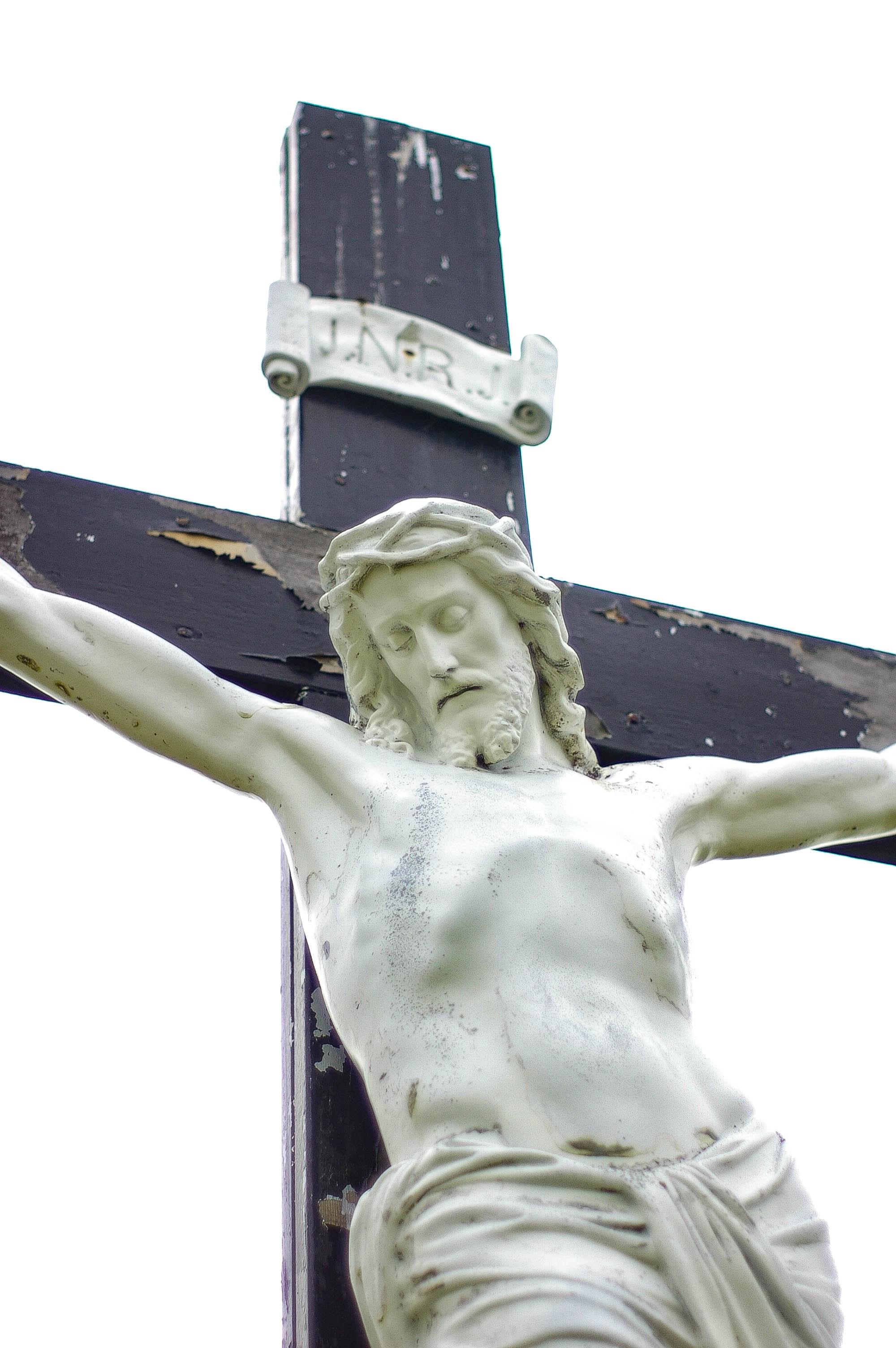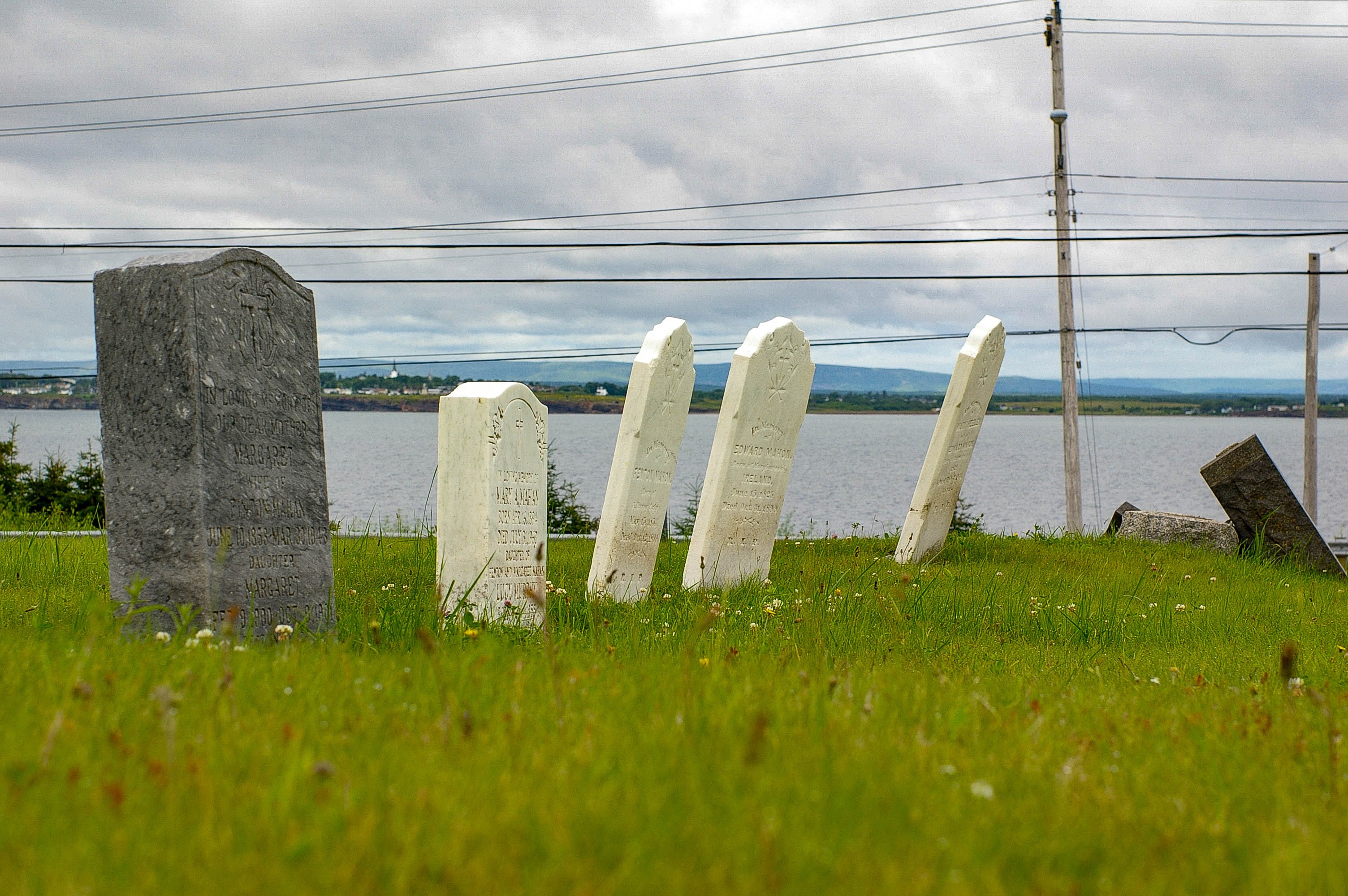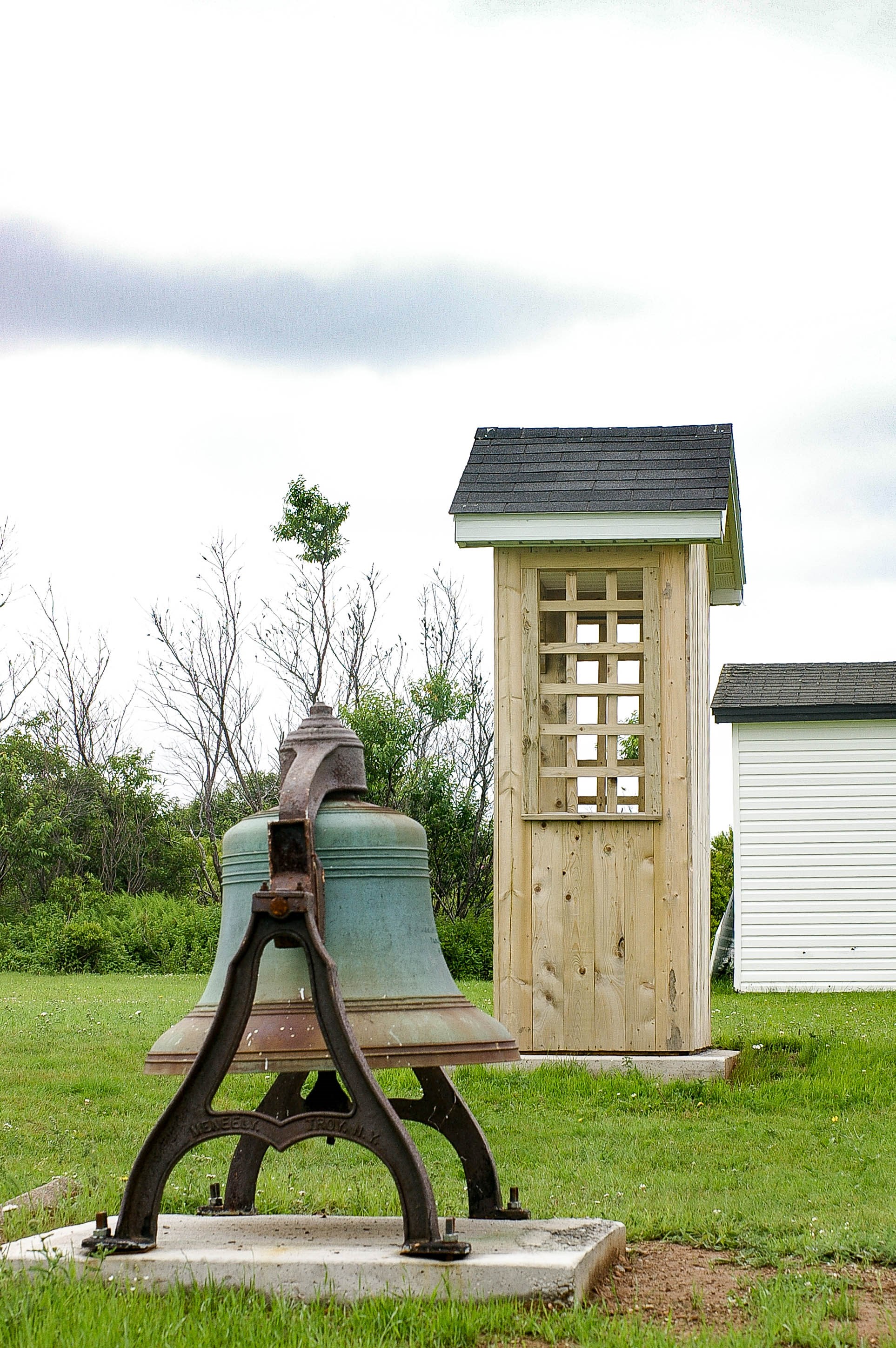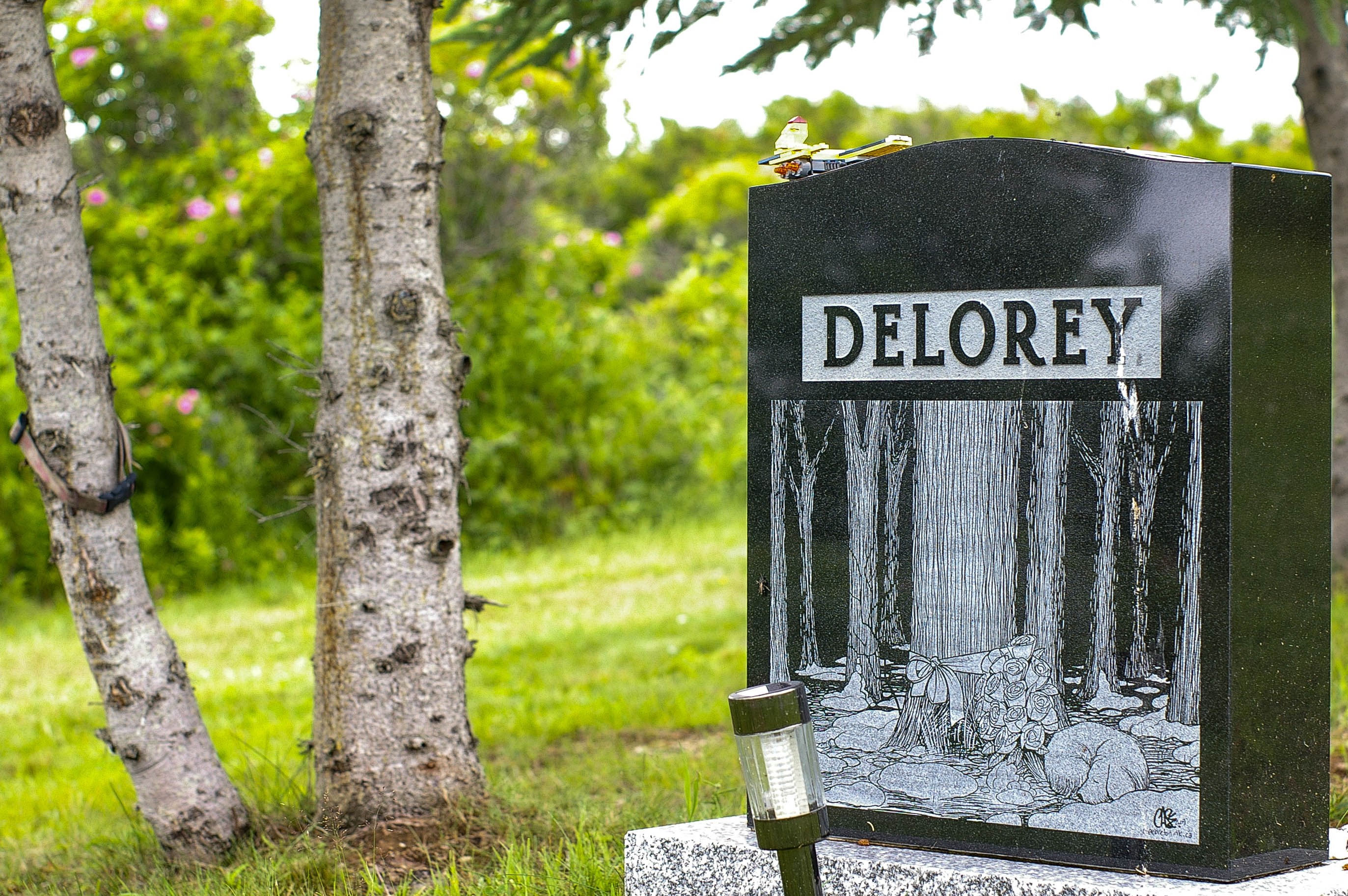If life is a journey (as a sage once said), then it's essential to stop and smell the flowers from time to time. Likewise, if life (as another sage once sang) is a highway, then one hopes it at least has rest stops. And if life is a cemetery -- setting aside all the metaphysical paradoxes inherent in that simile -- then at the very least, it ought to have benches.
Victoria Mines's splendid Saint Alphonsus Cemetery is a twofer: the older section is easily visible from Victoria Road as one drives northeast from Sydney, or southwestfrom New Waterford. In fact, it's nigh unmissable, not only because of the big, white-on-black crucifix that dominates the graveyard, but also because it's overlooked by Saint Alphonsus Church, one of the most beautiful churches in Cape Breton, and possibly in all the Maritimes.

"Welcome! Feel free to hang around awhile!"
Actually, counting the church, you get a threefer. Behind what's locally called the Stone Church, there is a second, newer cemetery, with a fascinating variety of headstones and -- best of all, after trudging up the soggy hill -- a bench.
But first things first. On the cloudy Thursday morning of our jaunt, our gravespotting quartet consisted of myself, my intrepid photographer Whitney Fawn, my four-year-old, and MJ, the child-minder. Since the 4YO has recently been more interested in playing chess than stalking graves, we brought along the chessboard, and fortunately there were several flat, sunken markers in the old cemetery that could serve as gaming surfaces.

Playing chess with Death deserves the right kind of board.
While half of our troupe was castling, the other half spread out to inspect the goods. Saint Alphonsus is a very spread-out cemetery; although it looks populous from the highway, its sloped, rolling ground seems a bit underutilized up close. Some markers cluster together near the dense underbrush that rings the churchyard, while a handful of ancient headstones sit perilously close to the road. Weather and erosion have clearly taken their toll here, so that even the newer stones appear to have shifted, sometimes splitting or tumbling apart completely into jenga piles of memorial stone.

In life, all Capers lean towards the sea. In death, that's a bad habit, indeed.
Most of the headstones here are badly weathered, but from what I could tell, most of the residents lives in the early 20th century, and many were first generation Canadians. Several graves had Italian epitaphs -- not surprising for a Catholic collection. But there are also several cases of early "lifers" -- children of European settlers born in Cape Breton during the island's early years. Such was the case with Mary Heelen, born in 1828 in Barrachois, not 20km from where she wound up. Mary is buried beside her husband Edward Mahon, who died five years before her, in 1899. From there, it gets complicated -- Edward 's stone (1825-1899) is just a wee bit closer to Fenton Mahon's grave (1853-1899) -- presumably Edward's son, though he died 19 days before his father. Finally, there are two Mahans (not "Mahon" but "Mahan"), one of which claims to have been married to "Finton." Were naming protocols just a whole lot looser back then, or is it simply that the dead don't spellcheck?

It doesn't matter how you're spelled. What matters is how your name stands up to time.
For a graveyard, Saint Alphonsus feels full of life. Not only is the busy highway ever-present, but the view from all points in the cemetery is breathtaking and vivacious: the crowded skyline of Sydney Mines and North Sydney, including the Newfoundland ferries, and beyond that, the Highlands bumbling up blue in the distance. Then there were the living visitors of Saint Alphonsus who dropped in on us: a murder of crows, a brace of bunnies, and a friendly husky dog, tied up on the residence next door, but with a long enough leash that he could come wag his tail at us as we squelched past.
After forty minutes of the grown-ups gravespotting, 4YO was getting restless, but a well-placed patch of tiny strawberries distracted him whist Whitney and I sought out the second leg of our journey -- up the hill and around to the back of the church, where a newer, flatter lichyard lay. With a denser, more conventional layout (making better use of real estate), you'd think this second cemetery would have been a disappointment, but in fact it was the highlight of the visit, for a number of reasons.
First, there were two benches. I'll admit I haven't been gravespotting for very long, but this is the first time I've seen a Cape Breton cemetery with spots to sit and reflect. One bench was the standard dark wrought-iron bench you'd find in downtown Sydney; though lacking in glutean comfort, it was at least well-situated beneath one of the few young pine trees that offer shade. The other was a recently built wooden bench with a cute little roof. If it weren't for the wasps' nest that had already moved in, this would have been the perfect settling site.

When the wasps descend upon you, ring the bell. Then run, obviously.
Of course, sitting around is pointless unless there's something worth seeing. Saint Alphonsus (Part II) has vistas in spades. Not only is the breathtaking Stone Church just a stone's throw away (more on that anon), but the graveyard is surrounded on the other three sides by riots of colourful wildflowers. There are even a few surprise colours -- like shockingly scarlet roses -- which turn out to be artificial flowers that got blown away from the graves and landed on the perimeter. There are probably better ways to pass the time than by guessing which flowers are fake, but I suppose it's nice to have the option.
Finally, you get a broad and satisfying range of headstones. My general aesthetic prefers pre-seventies markers, but only because the modern style tends towards homogenous, heart-shaped black granite. Here, the styles of each decade seem to complement the next: modest, sli, and classical 50s stones give way to the two-tone, cursive-scripted 70s space-hogs; the baroque 70s stones get more ostentacious (and segue from black to red) before yielding to loud, high-contrast 80s demi-arcs.

My Father's house has many rooms. And his grave has closet space!
This is also, I suspect, the resting place of a congregation that transcended class, for while some markers bespeak great wealth, some are heartbreakingly austere. And some are just plain heartbreaking. I have, thus far, managed to approach my gravespotting with a fairly dispassionate eye, but my breath caught when I found this child's grave beneath a tree.

The toy knocks your heart down a second time, and the dog's collar is the K.O.
Every grave is a life story in miniature, and a parish cemetery tells the story of a whole community. But for all its quirks and secrets, Saint Alphonsus Cemetery is overshadowed -- figuratively and literally -- by Saint Alphonsus Church, whose narrative is epic, and continues taking desperate and unexpected turns. Originally part of the Diocese of Antigonish, the 99-year-old church was closed in 2006 in response to shrinking congregations. Since then, two grassroots organizations have been rallying to it: the Stone Church Restoration Society and the St. Alphonsus Preservation Society. It seems as if the two groups have differing goals, reflected by their secular and religious names; early this year, the Preservation Society was dealt a blow when the Vatican rejected their appeal to keep the church from being deconsecrated. That leaves the secular Restoration Society with the daunting task of converting the church into a museum, or possibly a non-denominational wedding chapel. They've already raised an impressive $10,000, but the Diocese wants to wash its hands of the property soon.

Unlike many of the graves just down the hill, Saint Alphonsus still stands straight and tall. But for how long?
These days, the old building is uninsurable and therefore closed, but you can get right up close to admire its rose window facade, its tapering tower buttresses, and its twin belfries, each topped with four commanding spires. It is unquestionably a rare and impressive bit of Maritime architecture, and it would be a shame if the lands final living residents end up being bunnies, crows, and wasps. At this point, the Stone Church's future is not written in stone; here's a link to donate to the Restoration Society, if you want to help extend its story.
Scott Sharplin is a freelance writer and theatre artist, and an instructor at Cape Breton University. After growing up in Edmonton and studying in Montreal, he settled in Cape Breton to do the house-wife-dog-child-car thing. He is both active in, and a huge fan of, the Cape Breton theatre community. He lives in Sydney.
Whitney Fawn MacEachern was born in Virginia, and was fascinated since childhood by the creatures that live there. She spent her summers walking through the woods near her house, looking through field guides to identify the animals and plants. During the cool winters, she whiled away many hours drawing and crafting, honing her artistic skills. Whitney now lives in New Waterford with her husband and their two Maine **** cats.






1
Log In or Sign Up to add a comment.- 1
arrow-eseek-e1 - 1 of 1 items